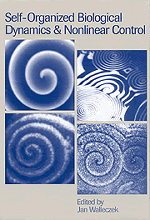 Self-Organized Biological Dynamics and Nonlinear Control
Self-Organized Biological Dynamics and Nonlinear Control Book contents
- Frontmatter
- Contents
- List of contributors
- Preface
- The frontiers and challenges of biodynamics research
- Part I Nonlinear dynamics in biology and response to stimuli
- Part II Nonlinear sensitivity of biological systems to electromagnetic stimuli
- Part III Stochastic noise-induced dynamics and transport in biological systems
- Part IV Nonlinear control of biological and other excitable systems
- Index
Part I - Nonlinear dynamics in biology and response to stimuli
Published online by Cambridge University Press: 14 August 2009
- Frontmatter
- Contents
- List of contributors
- Preface
- The frontiers and challenges of biodynamics research
- Part I Nonlinear dynamics in biology and response to stimuli
- Part II Nonlinear sensitivity of biological systems to electromagnetic stimuli
- Part III Stochastic noise-induced dynamics and transport in biological systems
- Part IV Nonlinear control of biological and other excitable systems
- Index
Summary
Part I introduces the terminology and definitions of key concepts in nonlinear dynamics and provides examples of their application at different levels of physiological organization. The examples show how common principles from nonlinear dynamics can be applied in the study of systems that differ greatly in terms of their material composition, scale of organization, and biological function. Chapter 1 by Friedemann Kaiser first reviews the reasons why nonlinear dynamics is critical to understanding biological function and order, and also provides a historical background. The chapter then introduces basic concepts and mathematical definitions that are essential to theoretical analyses of nonlinear biological phenomena, with a focus on model construction and responses to stimuli. Chapter 2 by Raima Larter and co-workers begins with a description of a nonlinear enzyme oscillator, the peroxidase–oxidase system, which is the best-characterized biochemical in vitro reaction showing diverse dynamics such as periodicity and bifurcation into chaos. Insights into the dynamical principles that govern the enzyme oscillator are then related to development of a model of neuroelectrical oscillations during epileptic brain activity.
- Type
- Chapter
- Information
- Self-Organized Biological Dynamics and Nonlinear ControlToward Understanding Complexity, Chaos and Emergent Function in Living Systems, pp. 13 - 14Publisher: Cambridge University PressPrint publication year: 2000


